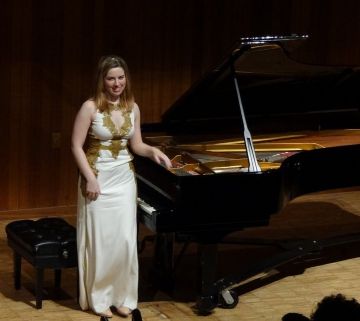|
Symphony
MONUMENTAL MAHLER 5TH IN SO CO PHIL'S SEASON ENDING CONCERT
by Terry McNeill
Sunday, April 14, 2024
Chamber
OAKMONT SEASON CLOSES WITH STRAUSS' PASSIONATE SONATA
by Terry McNeill
Thursday, April 11, 2024
Chamber
MORE GOLD THAN KORN AT ALEXANDER SQ CONCERT
by Terry McNeill
Sunday, April 7, 2024
Choral and Vocal
VIBRANT GOOD FRIDAY REQUIEM AT CHURCH OF THE ROSES
by Pamela Hicks Gailey
Friday, March 29, 2024
TWO OLD, TWO NEW AT THE SR SYMPHONY'S MARCH CONCERT IN WEILL
by Peter Lert
Saturday, March 23, 2024
Chamber
NOT A SEVENTH BUT A FIRST AT SPRING LAKE VILLAGE CONCERT
by Terry McNeill
Wednesday, March 20, 2024
THIRTY-THREE PLUS VARIATIONS AND AN OCEAN VIEW
by Terry McNeill
Saturday, March 16, 2024
Choral and Vocal
A ST. JOHN PASSION FOR THE AGES
by Abby Wasserman
Friday, March 8, 2024
Choral and Vocal
SPLENDID SCHUBERT SONGS IN SANET ALLEN RECITAL
by Terry McNeill
Saturday, March 2, 2024
Chamber
SHAW'S MICROFICTIONS HIGHLIGHTS MIRO QUARTET'S SEBASTOPOL CONCERT
by Peter Lert
Friday, March 1, 2024
|
 |
 Natasha Paremski Bows April 15 Following The Hersch Variations |
NATASHA PAREMSKI BRINGS DOWN THE HOUSE AND FINAL CONCERTS GRAND CURTAIN APRIL 15 IN NEWMAN
by Kenn Gartner
Sunday, April 15, 2012
Local favorite Natasha Paremski presented the final Concerts Grand recital of the ninth season April 15 with an eclectic program of super rare and super popular piano music. It was an exciting afternoon.
Miss Paremski is a deft verbal commentator with audiences and has great command of the instrument. Her octaves were almost like machine guns and her finger work in each of the five programmed pieces was elegant when necessary and forceful during passages which required strength.
The concert in SRJC’s Newman Auditorium began with Brahms’ F Sharp Major Sonata, Op.2, a work totally absent from programs in my memory. Her interpretation exceeded that of Julius Katchen, the pianist often associated with the recorded Brahms‘ oeuvre. Throughout the sonata there were huge contrasts in dynamics which helped delineate conversations between high and low registers, but occasionally this was accompanied by harsh sounds in the piano’s treble. The first movement begins with fistfuls of octaves done with drama and panache, and the second theme, two quarter notes plus a triplet, was heard clearly. The second movement developed large contrasts from piano
pianissimo to forte fortissimo and Ms. Paremski projected them with aplomb.
As with the program's concluding piece, Prokofiev's 7th Sonata, Brahms' third movement Scherzo allegro has a "military" configuration and difficult grace-note turns, which at speed are pesky, but here they were clear and sounded like explanations. The finale's subtle repeat showed how the artist could shade recurrent motives, albeit with a pedal that often blurred the line. It was rushed playing. The pianist's body English was ever present and enjoyed by the nearly packed audience. A standing ovation was the reward.
Jazz pianist Fred Hersch's Variations on a Theme from Tchaikovsky’s Fourth Symphony closed th first half, in its second performance anywhere. The premiere was April 14 at Sacramento State University. Written for Miss Paremski, the variations are not traditional in any sense and are tonal throughout with lots of 16th notes in both hands and triplets abounding. One variation had the left hand doing figurations over the right, followed by the right over the left, and the pianist wasn't happy with the results, saying "thanks Fred" and began the phrase again. The crowd loved her insoucience and me too. These innovative variations were certainly diverse: a tango, high register song, a Joplin knock off, bitonatity. New music performance is to be applauded and the composer Guillaume Machaut said "anything not composed within the past two weeks is not worth listening to."
Using the score, the performance didn't sound like it was sight read. Mr. Hersch could not have a better advocate for his work.
Two Chopin works began the second half, the dramatic F Minor Fantasie and the D Flat Berceuse (Op.57) with its rocking left hand ostinato figuration. In the Fastasie, one of Chopin's greatest works, Ms. Paremsky underscored the improvisitory and march-like passages, and in the sorcery of the Berceuse the ascending and descending right-hand arabesques were played with delicacy. The Fantasie was a "modern" performance with little rhythmic flexibility but interesting sforzando effects. It was a big boned conception.
Prokofiev's B-Flat Sonata was billed as the artist's signatue piece and she pushed the already fast tempos in the outer movements. The opening Allegro inquieto has a passage of nearly 32 bars which gets louder and faster and more agitato, and here Ms Paremski drove the envelope at least as far as Horowitz, and it was thrilling. The bluesy, jazzy interlude of a a second movement (a rose between two thorns?) received a calm and thoughtful interprepation, setting the stage for the famous precipitato finale. Here the 7/8 meter has an ostinato consisting of five notes over two measures, played in octaves. This is similar to the "clave" in Latin music. She stormed though it with hardly a nod to rubato or release, but the composer was said to have wanted it played like a machine.
Naturally it generated a storm of applause and Ms. Paremski returned to play Rachmaninoff's lovely C minor Etude Tablauex from Op.33. Here she phrased the captivating melody in what is really a nocturne with elegance and almost nostalgia.
|

